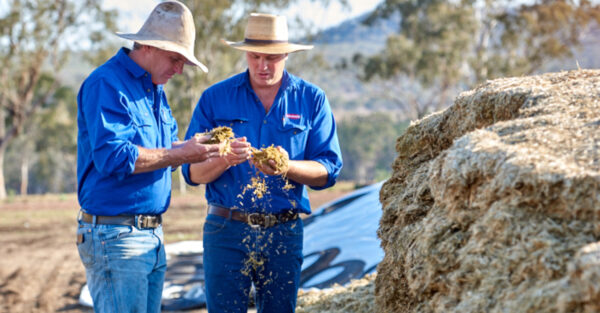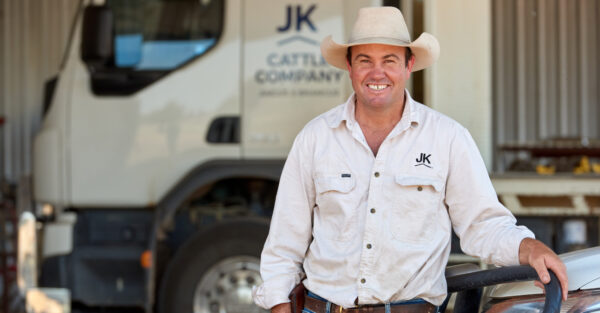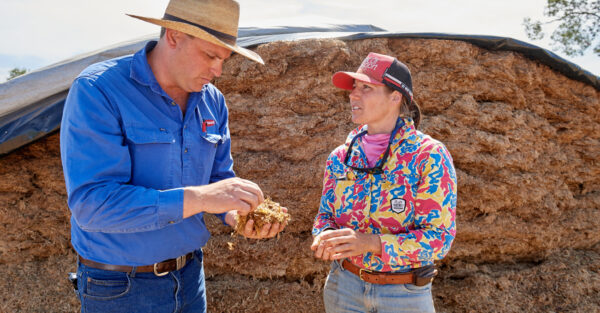Blog | Reading Time 4 minutes
Two bites at the same cherry
Queensland silage contractor and beef producer, Wayne Roche, is amazed by the quality of silage from a bun that has been opened twice in the past five years.
Wayne and Tanya Roche produce more than 100,000 tonnes of high quality silage for dairy and beef producers throughout southern Queensland and northern NSW each year.
They also operate a grain and beef enterprise, including a 150-head opportunity feedlot that’s used to grow out Angus weaners to 380-400 kg liveweight, on their 240 ha property outside Warwick.
Wayne sealed a 500 tonne stack of barley silage in 2017. “We opened it up the following March and fed it until September that year,” he says. “Cattle prices took a dive so we finished the pen and closed the feedlot.
“We’d only fed about a third of the stack, so we cleaned the face, put the plastic back on it and weighed it down with tyre walls as we normally do. We put some cattle back into the feedlot this July and we reopened the stack.
“I was really surprised at how little wastage there was. We scraped about 150 mm off the face and it was as good as the day it went it – it’s perfect in terms of colour, smell and palatability. A lot of people believe that once you open a pit, you have to feed it all but I would have no hesitation in resealing this pit a third time if I had to.”
Wayne attributes the outcome to the rapid advancements in inoculant and sealing technology over the past decade. “You need a good inoculant to control the fermentation process, good rolling and compaction to get the oxygen out and good sealing to keep it out,” he says.
Wayne is a staunch advocate of MAGNIVA Platinum inoculant and the Silostop sealing system from Lallemand Animal Nutrition. “MAGNIVA Platinum is easily the best inoculant I’ve used,” he says. “It really does keep the face of the stack cool once you open it up, which gives you more time to feed the silage out.”
MAGNIVA Platinum is a ‘next generation’ inoculant that combines a patented bacterium strain, Lactobacillus hilgardii CNCM I-4785, with the current industry benchmark, L. buchneri NCIMB 40788. This unique combination provides fast-acting ‘front end’ fermentation with proven ‘back end’ aerobic stability, allowing silage to be opened earlier and last longer after opening.
Silostop is an oxygen barrier film that prevents the entry of oxygen into silage, thereby limiting the growth of spoilage-causing yeasts and moulds. Independent testing has confirmed that Silostop is up to 100 times more effective than conventional polyethylene film in preventing the entry of oxygen. Silostop is used in combination with SilageKeeper UV covers, which protect the undercover against sunlight or potential damage
“This bun has been out in the open for five years and there’s no way conventional black and white plastic would have lasted this long,” Wayne says. “Black-and-white plastic is fine for short-term shortage but I recommend Silostop and SilageKeeper UV covers on everything that’s going to be stored for longer than two seasons.
“The only thing I wouldn’t recommend is baled silage. It’s uneconomic, labour intensive and it doesn’t last – and I know this first-hand because I’ve tried it.”
Wayne says there has been a marked increase in the use of silage by beef producers as part of their drought preparedness plans. “If you’re considering silage, then remember that your silage will only be as good as the crop you grow,” he says.
“Prepare your ground properly, apply a pre-emergent herbicide and adequate fertiliser to grow a good, clean crop as if you were going to harvest it for grain. Talk to your silage contractor about placement and preparation of your pit/stack. Cover your silage properly and don’t take any shortcuts on sealing.
“The other thing I’d say to beef producers who are considering getting into silage is to keep everything simple in terms of the ration and equipment until you are confident. We might make silage for a living, but here on our farm, we’re only using a bucket and a front-end loader. The trick is not to disturb the face of the stack and let oxygen into the bun.”
Raised on a dairy farm at Tannymorel, between Warwick and Killarney, Wayne has been making silage for more than 25 years. His business now employs six full-time staff and casual workers and boasts a fleet of high performance harvesting equipment, including two CLAAS JAGUAR 950 forage harvesters, fronts, tractors, prime movers and trailers.
Contact Lallemand Animal Nutrition for more information about how home-grown silage can help to ‘future proof’ your beef enterprise.
Published Dec 1, 2022
Related articles
Need specific information?
Talk to an expert


